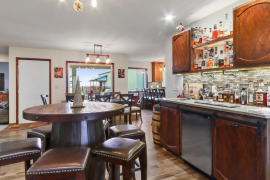By Kristine Hansen
Even in the 15 years since former Madison resident André Darlington started writing about cocktails, publishing several books on mixology, including this April’s Booze & Vinyl, co-authored with his sister Tenaya Darlington, he’s seen that world widen. “No one was drinking bitter drinks when I first started writing about cocktails. Now bitter drinks are the hot thing,” says Darlington, who now lives on the East Coast. He credits The Violet Hour and the Drawing Room in Chicago with kicking off the cocktail movement in the Midwest, followed by DISTIL in Milwaukee.
And dovetailing with the craft-cocktail trend are more glassware options available at retailers and specialty cocktail items. Unique bitters, small-batch (and sometimes local) liqueurs, tools to stir and shake, and published recipes just a Google search away are quickly coaxing home mixologists into worthy entertainers.
But the cost to stock a home bar can be daunting. Or, if space is limited, the fear you’re carving out a cramped corner in your home.
“In general, start small,” advises Julie Tominaro, owner of Crafty Kitchen, a personal-chef service in Lake Geneva. “Find out what your guests prefer to drink. Choose alcohol that you and your guests enjoy imbibing in.”
Darlington advises procuring just three bottles (gin, bourbon and Campari) to start—and growing from there when the time is right. Why these three? “Plymouth is a classic [gin] that a lot of bartenders use. It’s got a nice light profile. It’s not heavy,” explains Darlington. As for bourbon, “I really like Buffalo Trace. It’s really good bourbon for the money. Or Bulleit. That’s a great one for the shelf,” he says. The reason you want to include Campari into your home bar is for “something bitter,” says Darlington.
“With those three bottles, you can make martinis and Manhattans,” he says. Next, consider adding vodka and tequila to broaden your repertoire. Tominaro likes to keep sweet vermouth on hand as it’s “used in things like Manhattans and can add a lovely, slightly herbal but sweet characteristic,” she says. And dry vermouth is essential “for a proper martini, which is the king of cocktails,” Tominaro adds. “It’s also used in any number of other drinks, adding that herbal characteristic but an underlying dry note.” Just know that it should be tossed after a month—you always want to use fresh vermouth.
LOCAL LIBATIONS
By day, Christian Damiano is general manager at downtown Milwaukee’s Harbor House, a glass-enclosed restaurant that juts out into Lake Michigan. At night, he loves to tinker around in the bar he just installed in his Sussex home as part of a renovation. Included in the design is a copper-top bar, work station, dishwasher, sink, glassware storage and wine fridge. His carpenter father-in-law built the top-notch cabinets.
He’s been very impressed with Wisconsin-made spirits and tonics. “Great Lakes Distillery has put themselves on the map and local distilleries on the map,” says Damiano. “[Twisted Path Distillery’s] gins are just beautiful; very aromatic. They’ve [also] got a really fantastic vodka.” Top Note’s health-minded tonics are another product he does not hesitate to recommend. “They don’t use corn syrup. Their flavor profile is really nice,” he says.
In addition to spirits and liqueurs, Damiano recommends stocking your home bar with a nice cutting board, sharp knife and fresh citrus, like limes, lemons, oranges or clementines. “It changes the flavor profile ever so slightly,” he says, when you switch up your citrus choice from, say, a lemon to a clementine that’s in season.
And don’t even think about skimping with a refrigerated plastic container of store-bought lemon or lime juice. After all, this is all about entertaining: “For your home, always make it the best,” says Damiano. To make a batch of drinks for a small crowd, “you want to have more than two shakers on hand, plus a muddler and a strainer,” he says.
Glassware choices can also feel overwhelming. Damiano advises purchasing, to start, 12- to 14-ounce tumbler glasses. “You can put just about anything into them,” he says. But if you really want to mimic a bar, Tominaro suggests buying the following glassware and tools: martini, rocks, highball, tall, red and white wine glasses; pint glasses; beer mugs; a martini shaker and strainer; toothpicks for olives and condiments; and cocktail napkins. Party-goods stores often stock toothpicks and napkins in bulk.
And you can never have too many garnishes on hand. Some basic ones, in addition to limes and lemons, says Tominaro, are cocktail olives and onions, horseradish, salt and pepper, Tabasco sauce and sugar. These can easily jazz up a cocktail. Basic mixers, she says, to keep chilled in the fridge include club soda, tonic water, soda (Coca-Cola, Sprite or 7UP, and ginger ale) and juice (orange, cranberry, tomato or pineapple).
Darlington has an ice tip, too. “Ice takes on the flavor of your freezer,” he says. “Use ice not older than two weeks.” And don’t feel like you have to load up on barware all at once. Once you’ve got your bottles, glassware and shaker, add gradually as you learn what you—and your guests’—palate likes. “You don’t need a lot of fancy barware, but you do need a good shaker,” says Darlington, who has suggested for people who lack a stirrer that they use chopsticks instead.
SOME TIPS ON SIPS
What’s old is new again—even when it comes to cocktails. “Classic cocktails are coming back—with a twist,” says Christian Damiano, general manager at Harbor House in Milwaukee. Some examples at Harbor House are the Cranberry Orange Manhattan and Autumn Negroni, bumping up against signature drinks, craft beer and glasses of bubbles on the bar menu. “People want flavor. They don’t necessarily want a ton of sugar added,” he says. (In other words, no drinks that replicate desserts, or martinis rich as chocolate bars.) “Bourbons and ryes are very much top of mind,” he says. To play around with classic cocktails, make sure you have a bourbon and rye on hand, and your repertoire will go far.
RECIPES
Apricot Smash
- 2.5 oz. Four Roses bourbon
- 1 fresh orange section
- Apricot preserves, muddled
- 1 fresh mint sprig
Shake first three ingredients and serve over ice with a mint sprig for garnish. Courtesy of Harbor House
Champagne Cosmo
- 2 oz. Grey Goose vodka
- ¼ oz. Cointreau
- ½ oz. cranberry juice
- Juice of ½ fresh lime, squeezed
- ½ oz. Champagne
Shake first four ingredients. Float ½ oz. Champagne and serve. Courtesy of Harbor House
South Side
- 2 oz. gin
- ¾ oz. lime juice
- ¾ oz. simple syrup
- 6 fresh mint leaves
Muddle the mint leaves with simple syrup in a shaker. Add other ingredients and shake. Courtesy of André Darlington





